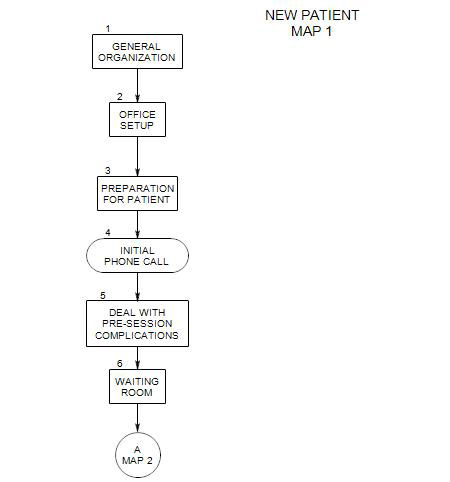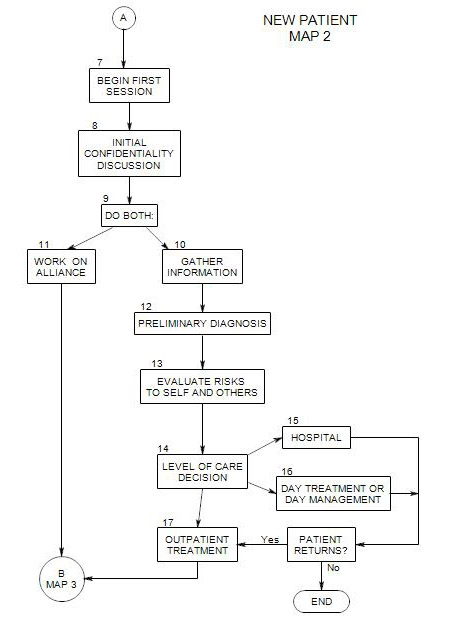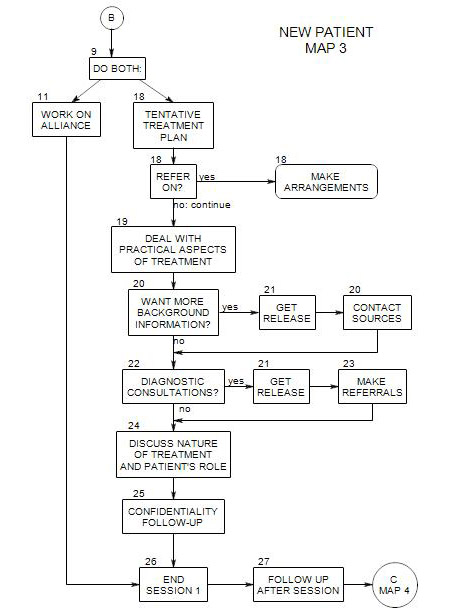-
Follows Section 1 on Map 1
Your choices in setting up an office both reflect you and your practice and contribute to your own experience and the development of your practice.The assumption here is that you are setting up a private practice office. If you are working in a clinic, many of these decisions will already have been made, and you will have to accept them.
There are many characteristics of your office and your practice, some you create, some you choose, and some you live with and accommodate to.
First, you must decide which governs:
- the patient population you want to work with
- the therapy issues you want to treat
- the office location
It is unlikely that you will be able to choose all three. To some extent, your choice of one or more aspect of your practice will at least partly determine the other or others.
For example, if you want to work with wealthy, cash-only patients, you may find that they won’t come to an office in an industrial building or a run-down neighborhood. At the opposite extreme, if you set up an office in your home in a well-to-do suburban neighborhood, poor patients may not be able to find transportation to see you.
Keep in mind that anything you present – or fail to present – to a patient will be interpreted as a statement about you and the work you do. As much as possible, it pays to be aware of possible interpretations and manage them to promote the treatment.
Background of Safety
All aspects of office setup should be related to basic principles of safety, openness, change, and respect for patient needs and goals.
Issues
- Privacy, anonymity. The ideal is that no one should be able to find out about the patient’s coming and going, and certainly not about what is being said.
- Comfort. You want the office setting to be comfortable enough not to be distracting.
- Convenience. Getting to you shouldn’t be an issue; but it might be. Some people will go great distances to get the treatment they want.
Geographic Location
- convenient to patient population, esp intended modes of transportation
- type of building: home, office building, clinic
- Modifying an existing office or building to be more suitable. Limits of ability to adapt and need to keep searching.
Dealing With Local Norms and Circumstances
Much of psychodynamic writing came out of large cities and behavioral writing came from academic settings. In both settings therapist and patient can be kept separate. In a small town, it is harder for you to remain isolated, a blank slate to your patients. To try to do so makes you seem peculiar, perhaps less trustworthy. How do you deal with that?
Waiting Room
- who else waits there? Is it shared? What do you do when people run into other people they know? Should you warn them? Should you stagger sessions with other users, to avoid contact between patients?
- how public is it? Is it used for some other purpose, eg: a playroom for your children? A waiting room for a lawyer or an accountant?
- Is it shared with other therapists? If so, do patients sometimes wait in the presence of other patients? What are they thinking?
- what supplies? Magazines, toys, etc.
- how big, and how furnished? The waiting room prepares people for their sessions. A waiting room that is dark, dirty, uncomfortable, overly bright, sterile, etc., will affect your patients’ attitudes toward you and the treatment. You might what it resembles: a closet? A bus depot? A hallway with plastic chairs?
- What if you don’t have a waiting room? May be compensated-for by being on time and spacing patients with time between sessions. However, there is always a risk that a schedule confusion will result in a patient walking in on another’s session, or that a session that runs over will result in two patients confronting each other.
Physical Plant of Office
- sound transmission and walls and doors. No one should be able to hear what’s happening in session, and patients should know that. One bad example: an office on the second floor of a three story building used by a lot of therapists. This office had been a business, with large windows that overlooked the street and sidewalk. The therapist and patient sat in front of the windows talking in full view of passersby. Not very private.
- relationship of office to other offices, outside door, toilet, waiting room
- door buzzer when patient arrives: so patient isn’t kept waiting
What the Office Communicates to Patients
People get an immediate impression of you and your treatment from the ambiance in the waiting room and office.
- colors: do you want the overall impression to be of a bright, cheery place, a somber place, a comfortable place?
- Real vs. artificial: what is the quality of the furniture and art? How does it reflect the expectations and values of your patient population while at the same time making a statement about you?
- What statement do you want the office to make about you, and how much of a statement?
- How masculine or feminine should the office be?
- What does the office resemble: a medical office? A private living room?
- pictures on the wall
- Personal artifacts may say too much. Total lack of personal artifacts may also lead to an impression of the therapist and therapy.
- Tone of Treatment: Formal, serious vs relaxed, comfortable
Personal Style of Therapist
Style and Décor
- certificates on the wall. What is their function: to impress? To reassure? To decorate?
- office-like or home-like
- plants. Some people take comfort in live plants – if they are well tended and look thriving
- books and journals. What to display and why. Another form of communication to patients
Furniture
- kinds of chairs, how comfortable?
- placement of furniture and message to patients [eg: Dr behind a large desk] [Patient’s chair higher than therapist’s] [ability of therapist to be out of patient’s sight if visual feedback is distracting]
- Type of furniture straight-back wooden chairs vs recliners.
- Depends on what you do: psychoanalysis and couple therapy would suggest having a couch
- Quality and style of furniture makes a statement about the therapist
- How far apart to place the chairs: too distant vs too intrusive and intimate
Equipment
- sound machine in waiting room
- door buzzer and flapper
- radio in waiting room. What stations are played, and who decides?
- audio or video equipment in session. What purpose and how much of the time? Impact on patient’s sense of privacy? Affect on patient’s willingness to be open?
Toilet – availability. What do people do in case of emergency?
Patient Files
- How much to keep on each patient? Legal protection.
- How to collect the information?
- Forms, timing.
- What kinds of records to keep
- where to keep it? Privacy issues, HIPAA.
Other Records
- information about available resources: other therapists, hospitals, self-help groups, etc.
Scheduling
- space between patients, for privacy
- Time of day of office hours.
- Deciding on maximum number of treatment hours per week
- Regularity vs. irregular or haphazard. Has to do with seriousness. At the other end, can have to do with rigidity and control, as in the case of the analyst who insisted that patients always pay for missed sessions, and that the only weeks without scheduled sessions were weeks the analyst took for vacation.



